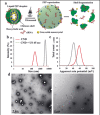The Daniel K. Inouye College of Pharmacy Scripts: Targeted Nanocarrier Based Systems for the Treatment of Lung Cancer
- PMID: 29164017
- PMCID: PMC5694976
The Daniel K. Inouye College of Pharmacy Scripts: Targeted Nanocarrier Based Systems for the Treatment of Lung Cancer
Abstract
In Hawai'i, lung cancer is among the top cancers diagnosed and a leading cause of death. Despite current understanding and modern surgery, radiology, and chemotherapy techniques, the survival of those suffering from lung cancer remains low. Current anticancer drugs have poor tumor tissue selectivity and toxicity issues that contribute to their overall low efficacy, detrimental effects to normal tissues, and drug resistance. A potential way of mitigating cancer is through RNA interference (RNAi) by the delivery of small interfering RNA (siRNA) to target select proteins or genes involved in cancer progression, known as oncoproteins or oncogenes, respectively. However, the clinical utility of delivering unformulated siRNA has been hindered due to poor cell penetration, nonspecific effects, rapid degradation, and short half-life. As an alternate for conventional chemotherapy, nanoparticles (AKA nanocarriers) may be designed to localize within the tumor environment and increase targeted cell internalization, thus reducing systemic adverse effects and increasing efficacy. Nanoparticles play important roles in drug delivery and have been widely studied for cancer therapy and diagnostics, termed collectively as theranostics. Nanoparticles composed of natural and artificial polymers, proteins, lipids, metals, and carbon-based materials have been developed for the delivery of siRNA. Cancer targeting has been improved by nanoparticle surface modification or conjugation with biomolecules that are attracted to or stimulate therapeutic agent release within cancer tissues or cells. In this mini-review article, we present recent progress in nanocarrier-mediated siRNA delivery systems that include lipid, polymer, metallic and carbon-based nanoparticles for lung cancer therapy.
Conflict of interest statement
None of the authors identify any conflict of interest.
Figures




Similar articles
-
Nanoparticle-mediated delivery of siRNA for effective lung cancer therapy.Nanomedicine (Lond). 2015;10(7):1165-88. doi: 10.2217/nnm.14.214. Nanomedicine (Lond). 2015. PMID: 25929572 Review.
-
Advanced targeted therapies in cancer: Drug nanocarriers, the future of chemotherapy.Eur J Pharm Biopharm. 2015 Jun;93:52-79. doi: 10.1016/j.ejpb.2015.03.018. Epub 2015 Mar 23. Eur J Pharm Biopharm. 2015. PMID: 25813885 Review.
-
Recent Advances in Treatment of Lung Cancer: Nanoparticle-based Drug and siRNA Delivery Systems.Curr Drug Deliv. 2021;18(2):103-120. doi: 10.2174/1567201817999200730211718. Curr Drug Deliv. 2021. PMID: 32748745 Review.
-
Nanoparticles for targeted delivery of therapeutics and small interfering RNAs in hepatocellular carcinoma.World J Gastroenterol. 2015 Nov 14;21(42):12022-41. doi: 10.3748/wjg.v21.i42.12022. World J Gastroenterol. 2015. PMID: 26576089 Free PMC article. Review.
-
Nanocarrier mediated delivery of siRNA/miRNA in combination with chemotherapeutic agents for cancer therapy: current progress and advances.J Control Release. 2014 Nov 28;194:238-56. doi: 10.1016/j.jconrel.2014.09.001. Epub 2014 Sep 7. J Control Release. 2014. PMID: 25204288 Free PMC article. Review.
References
-
- HCCC, author; Coalition HCC, editor. Hawai'i State Cancer Plan 2016–2020. 2016.
-
- Detailed Guide to Lung Cancer (Non-Small Cell), author American Cancer Society, 2014. 2014. [10/22/14]. http://www.cancer.org/cancer/lungcancer-non-smallcell/detailedguide/non-....
-
- Hawaii at a Glance. Cancer Statistics Center 2017. 2017. [09/19/2017]. https://cancerstatisticscenter.cancer.org/#/state/Hawaii.
-
- American Cancer Society, author. Cancer Facts & Figures 2015. Atlanta: American Cancer Society; 2015.
Publication types
MeSH terms
Substances
Grants and funding
LinkOut - more resources
Full Text Sources
Medical
Research Materials

